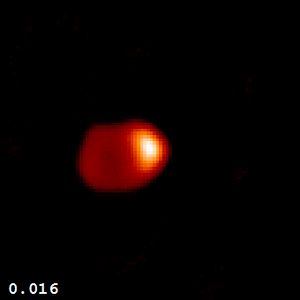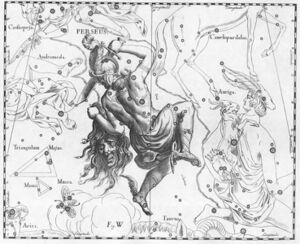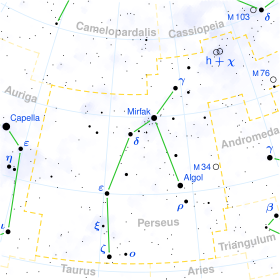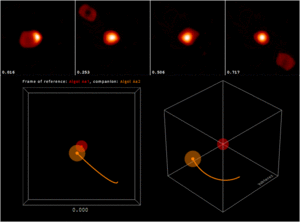رأس الغول
رأس الغول Algol (β Per / Beta Persei) اسم ثاني أكثر النجوم تألقاً في مجموعة فرساوس الفلكية. يبعد نجم رأس الغول عن الأرض نحو 100 سنة ضوئية. انظر: السنة الضوئية. وهو نوع من النجوم المزدوجة التي تُدعى الثنائي الكسوفي. وفي ذلك الثنائي هناك نجمتان تدور كل منهما حول الأخرى فتحجب إحداهما ضوء الأخرى من حين إلى آخر، مما يؤدي إلى تخفيف تألق النجمة المزدوجة عندما نراها من الأرض.
ويستطيع الإنسان أن يشاهد اختلاف درجات التألق بالعين المجردة. ففي كل ثلاثة أيام تقريبًا يفقد نجم رأس الغول ثلثي نسبة تألقه خلال خمس ساعات، ثم يعود إلى مغنطيسيته المعتادة 2,3. انظر: النجمة.
تقدر المسافة الواقعة بين مركزي النجمتين بنحو 11مليون كم. وتبلغ درجة حرارة سطح إحداهما حوالي 12,000°م، أما حرارة النجمة الأخرى ـ وهي أخف تألقاً ـ فهي ثلث هذه الدرجة فقط. وهناك نجمة ثالثة، وأكثر بعدًا تابعة لنظام نجمة رأس الغول، وتدور حول النجمتين السابقتين، ولكنها لا تؤدي دورًا في ظواهر الكسوف.
تاريخ الرصد
| Date | Time |
|---|---|
| October 1, 2020 | 21:05 |
| November 1, 2020 | 19:01 |
| December 3, 2020 | 08:00 |
| January 3, 2021 | 21:01 |
| February 1, 2021 | 14:03 |
| March 1, 2021 | 09:27 |
| April 2, 2021 | 18:29 |
| May 1, 2021 | 10:40 |
| June 1, 2021 | 23:38 |
| July 3, 2021 | 12:35 |
| August 1, 2021 | 04:41 |
| September 1, 2021 | 17:35 |
| October 3, 2021 | 06:30 |
| November 3, 2021 | 19:27 |
| December 2, 2021 | 11:36 |
النظام

| Components | Semimajor axis | Ellipticity | Period | Inclination |
|---|---|---|---|---|
| A—B[11] | 0.00218″ | 0.00 | 2.87 days | 97.69° |
| (AB)—C[12] | 0.09461″ | 0.225 | 680.05 days | 83.98° |
الأسماء
Beta Persei is the star's Bayer designation. The name Algol derives from Arabic رأس الغول raʾs al-ghūl : head (raʾs) of the ogre (al-ghūl) (see "ghoul").[13] The English name Demon Star was taken from the Arabic name.[14] In 2016, the International Astronomical Union organized a Working Group on Star Names (WGSN)[15] to catalog and standardize proper names for stars. The WGSN's first bulletin of July 2016[16] included a table of the first two batches of names approved by the WGSN; which included Algol for this star. It is so entered on the IAU Catalog of Star Names.[17]
In Hebrew folklore, Algol was called Rōsh ha Sāṭān or "Satan's Head", as stated by Edmund Chilmead, who called it "Divels head" or Rosch hassatan. A Latin name for Algol from the 16th century was Caput Larvae or "the Spectre's Head".[14] Hipparchus and Pliny made this a separate, though connected, constellation.[14]
In Chinese, 大陵 (Dà Líng), meaning Mausoleum, refers to an asterism consisting of β Persei, 9 Persei, τ Persei, ι Persei, κ Persei, ρ Persei, 16 Persei and 12 Persei. Consequently, the Chinese name for β Persei itself is 大陵五 (Dà Líng wu, English: The Fifth Star of Mausoleum.).[18] According to R.H. Allen the star bore the grim name of Tseih She 積屍 (Zhi Shī), meaning "Piled up Corpses"[14] but this appears to be a misidentification, and Dié Shī is correctly π Persei, which is inside the Mausoleum.[19]
الأهمية الثقافية
The constellation Perseus and Algol, the Bright Star in the Gorgon's head | |
|---|---|
 Johannes Hevelius, Uranographia, 1690 |
Historically, the star has received a strong association with bloody violence across a wide variety of cultures. In the Tetrabiblos, the 2nd-century astrological text of the Alexandrian astronomer Ptolemy, Algol is referred to as "the Gorgon of Perseus" and associated with death by decapitation: a theme which mirrors the myth of the hero Perseus's victory over the snake-haired Gorgon Medusa.[20] Astrologically,[مطلوب توضيح] Algol is considered one of the unluckiest stars in the sky,[14] and was listed as one of the 15 Behenian stars.[21]
انظر أيضاً
- رأس الغول في الخيال
- Jaana Toivari-Viitala, egyptologist who contributed to understanding Ancient Egypt and the star
المصادر
- ^ أ ب ت ث ج Van Leeuwen, F. (2007). "Validation of the new Hipparcos reduction". Astronomy and Astrophysics. 474 (2): 653–664. arXiv:0708.1752. Bibcode:2007A&A...474..653V. doi:10.1051/0004-6361:20078357. S2CID 18759600.
- ^ أ ب ت Ducati, J. R. (2002). "VizieR Online Data Catalog: Catalogue of Stellar Photometry in Johnson's 11-color system". CDS/ADC Collection of Electronic Catalogues. 2237: 0. Bibcode:2002yCat.2237....0D.
- ^ أ ب Samus, N. N.; Durlevich, O. V.; et al. (2009). "VizieR Online Data Catalog: General Catalogue of Variable Stars (Samus+ 2007–2013)". VizieR On-line Data Catalog: B/GCVS. Originally Published in: 2009yCat....102025S. 1: 02025. Bibcode:2009yCat....102025S.
- ^ أ ب ت Lestrade, Jean-Francois; Phillips, Robert B.; Hodges, Mark W.; Preston, Robert A. (1993). "VLBI astrometric identification of the radio emitting region in Algol and determination of the orientation of the close binary". The Astrophysical Journal. 410: 808. Bibcode:1993ApJ...410..808L. doi:10.1086/172798. ISSN 0004-637X.
- ^ أ ب ت ث ج ح خ Soderhjelm, S. (1980). "Geometry and dynamics of the Algol system". Astronomy and Astrophysics. 89 (1–2): 100. Bibcode:1980A&A....89..100S.
- ^ أ ب ت ث ج ح خ د Baron, F.; Monnier, J. D.; Pedretti, E.; Zhao, M.; Schaefer, G.; Parks, R.; Che, X.; Thureau, N.; Ten Brummelaar, T. A.; McAlister, H. A.; Ridgway, S. T.; Farrington, C.; Sturmann, J.; Sturmann, L.; Turner, N. (2012). "Imaging the Algol Triple System in the H Band with the CHARA Interferometer". The Astrophysical Journal. 752 (1): 20. arXiv:1205.0754. Bibcode:2012ApJ...752...20B. doi:10.1088/0004-637X/752/1/20. S2CID 11110989.
- ^ أ ب ت ث ج ح Zavala, R. T.; Hummel, C. A.; Boboltz, D. A.; Ojha, R.; Shaffer, D. B.; Tycner, C.; Richards, M. T.; Hutter, D. J. (2010). "The Algol Triple System Spatially Resolved at Optical Wavelengths". The Astrophysical Journal Letters. 715 (1): L44–L48. arXiv:1005.0626. Bibcode:2010ApJ...715L..44Z. doi:10.1088/2041-8205/715/1/L44. S2CID 118573026.
- ^ Tomkin, J.; Huisong, T. (1985). "The rotation of the primary of Algol". Publications of the Astronomical Society of the Pacific. 97: 51. Bibcode:1985PASP...97...51T. doi:10.1086/131493.
- ^ Edgar, James S. (editor). Observer's Handbook 2020. The Royal Astronomical Society of Canada. ISBN 9-781927-879191.
- ^ Ashford, Adrian (30 July 2006). "The Minima of Algol". Retrieved 2018-12-04.
- ^ L. A. Molnar, R. L. Mutel (1996). "Dynamical Evolution of the Algol Triple System". Bulletin of the American Astronomical Society. 28: 921. doi:10.1007/BF00215914.
- ^ W.I. Hartkopf, B.D. Mason (2006-07-30). "Sixth Catalog of Orbits of Visual Binary Stars". U.S. Naval Observatory. Retrieved 2006-07-31.
- ^ P. Kunitzsch & T. Smart, Short Guide to Modern Star Names and Their Derivations (Wiesbaden: Otto Harrassowitz, 1986), p 49.
- ^ أ ب ت ث ج Allen, R. H. (1963) [1899]. Star Names: Their Lore and Meaning (Reprint ed.). New York: Dover Publications Inc. p. 331. ISBN 978-0-486-21079-7.
- ^ "IAU Working Group on Star Names (WGSN)". Retrieved 22 May 2016.
- ^ "Bulletin of the IAU Working Group on Star Names, No. 1" (PDF). Retrieved 28 July 2016.
- ^ "IAU Catalog of Star Names". Retrieved 28 July 2016.
- ^ (in صينية) AEEA (Activities of Exhibition and Education in Astronomy) 天文教育資訊網2006年7月11日
- ^ Ian Ridpath's Star Tales – Perseus
- ^ Robbins, Frank E. (ed.) 1940. Ptolemy: Tetrabiblos. Cambridge, Massachusetts: Harvard University Press (Loeb Classical Library). ISBN 0-674-99479-5, IV.9, p.435.
- ^ Henry Cornelius Agrippa (1898). Three Books of Occult Philosophy. Lyons, 1531/33. Llewellyn reprint, 1993; tr. J. Freake (1651), ed. D. Tyson, p.411.
وصلات خارجية
- "HD 19356 -- Eclipsing binary of Algol type". SIMBAD. Retrieved 2006-07-31.
- "Beta Persei (Algol)". AAVSO. 1999. Retrieved 2006-07-31.
{{cite web}}: Unknown parameter|month=ignored (help) - "The Horror-Scope of Algol". Skyscript. 2005. Retrieved 2006-07-31.
{{cite web}}: Unknown parameter|month=ignored (help) - "Algol 3". SolStation. Retrieved 2006-07-31.
- "4C02517". ARICNS. 1998-03-04. Retrieved 2006-07-31.
- "Algol". Alcyone ephemeris. Retrieved 2006-06-08.
- Kaler, Jim. "Algol (Beta Persei)". Stars. Retrieved 2006-06-08.
- Bezza, Giuseppe [translated by Daria Dudziak]. "Al-ghûl, the ogre". Cielo e Terra. Retrieved 2006-06-08.
- Czech space metal band "Realm of Algol"
- Articles with صينية-language sources (zh)
- Short description is different from Wikidata
- Articles containing explicitly cited عربية-language text
- Articles containing صينية-language text
- Articles with hatnote templates targeting a nonexistent page
- Articles using infobox templates with no data rows
- جميع الصفحات التي تحتاج تنظيف
- مقالات بالمعرفة تحتاج توضيح from July 2011
- CS1 errors: unsupported parameter
- Algol variables
- كلمات وعبارات عربية
- أجرام باير
- B-type main sequence stars
- أجرام فلامستيد
- أجرام هيپاركوس
- HD and HDE objects
- HIP objects
- K-type subgiants
- Perseus constellation
- نجوم بأسماء خاصة
- Triple star systems
- Astronomical objects known since antiquity
- فهرس النجوم الساطعة
- أجرام زيج بون
- Am stars


